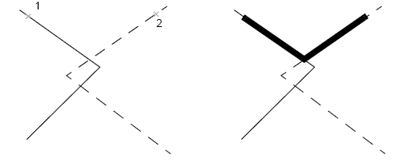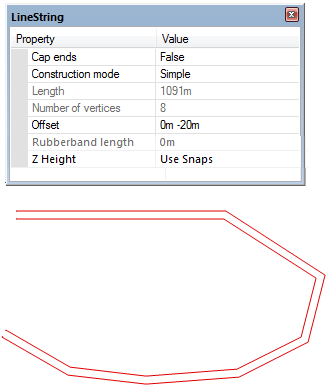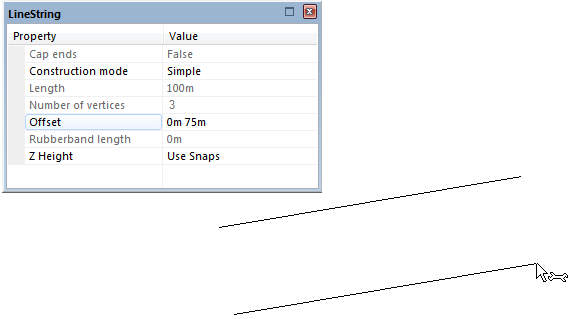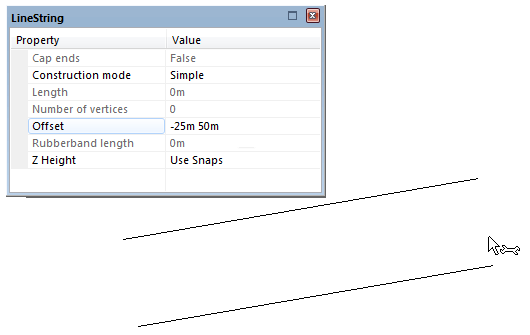LineString creates LineString items containing one or more segments.
When you select LineString the following LineString dialog is displayed:

The LineString dialog remains displayed while the command is in force, this allows you to change LineString parameters at any time, even while drawing a LineString item.
The properties and their values in the LineString dialog are as follows:
Cap ends
.png)
True
Caps the ends of pairs of LineString items when using multiple offsets, e.g. to draw a wall. See Offset on this page for details of creating mutliple offsets.
False
Does not use cap ends.
Construction mode
Construction mode affects how snapped or typed positions are interpreted, and also the offset from those positions from which to create the LineString item. You can freely switch between these modes during LineString item construction.
.png)
Simple
You may enter the start position of the LineString item by snapping to a position on the screen, or typing a coordinate. You may then keep on inputting points (by snaps or coordinates), and each time a LineString item segment will be drawn to the new position. Press Enter when you have finished the LineString item, or Ctrl + Enter if you have drawn a LineString item of 2 or more segments and wish to close the LineString item back to the first point (effectively creating a closed LineString item). You can also double-click to finish the LineString item.
If you make a mistake and need to remove a point, press the Backspace key. This removes the last point input, each subsequent press of the Backspace key will backtrack through the previous points.
Trace
This mode constructs a LineString item by tracing over existing graphics. This overcomes many of the frustrations normally encountered when tracing over existing graphics. Used in conjunction with the ability to pan and zoom over the map in mid-command, and the facility for having more than one view of the map displayed, tracing over base data can become a simple and reliable task.
Snap or type a position for the start of the trace. This starts the trace anywhere on the map, but as you are tracing, you may want to choose a vertex on the geometry to be traced.
Snap a position to trace to. Clicking the mouse when the cursor is over existing geometry will cause SIS to search for a continuous path between the first and second point. The trace will follow exactly over the path of the geometry being traced, irrespective of how many intermediate vertices it contains.
The trace sequence is drawn on screen using a thick outline. You can press the Backspace key to return to the previous trace point, or Shift+Backspace to step back over the vertices of the last intermediate trace sequence.
The trace path will not jump between different bits of geometry. However, if you trace to the intersection between two pieces of geometry, or where two geometry ends meet, then the trace will be able to jump across the intersection.
To trace over an existing geometry completely, click the first point, then hold the Ctrl key down, and click anywhere along the geometry to be traced, near to the first point in the direction you wish to trace. SIS will not insert a vertex at this point, but will attempt to trace the geometry right to its end, no matter how long this is, or how many intermediate vertices are needed.
If you do not wish to follow existing geometry, you can enter a position while holding the Shift key to jump directly to the position you input, which need not be on existing geometry.
In addition, if the start and end positions of a trace segment are on topological Link items, SIS will automatically perform a topological route-find using a shortest-route algorithm.
Press the Enter key to accept the trace sequence, or press Ctrl+Enter to close the shape, joining the last point back to the first. A LineString item will be created along the traced path.
Difficulties you may encounter when tracing external map data
Vector-based maps such as those supplied by Ordnance Survey have been created by digitising existing paper maps. These paper maps are supplied in tiles. Where a feature such as a road centreline or road edge comes to the edge of one of these map tiles, the graphics stop, starting again on the adjacent map. The digitised line will therefore stop at an unexpected place.
The person digitising the original data may have stopped the line at a position which seemed appropriate, but may not not suit your requirements.
Graphics may have been digitised using lots of points, which will have resulted in many vertices.
Find route
SIS will look for a route between the positions you enter. The route can be made up of geometry from any item. If your positions are far apart, then SIS may spend some time looking for a route.
By clicking on two points on an existing LineString item or on two overlying LineString items, the shortest route between these two points is calculated, and a LineString item constructed along this route.

This feature is useful when used with link and node networks, when it will respect flow directions assigned to links, and turning rules applied at nodes (junctions).
You can also use Point-to-point [Analysis-Routing] to create new LineString items that follow routes.
Orthoganol
All of the LineString item segments will be corrected to be parallel to the X and Y-axes, giving right-angled corners. If you wish to draw LineString items at angles other than 0, 90, 180 and 270 degrees, you must first change the orientation of the axes Rotate [CAD-Axes].

Right angles
Each LineString item segment will be created at right-angles to the previous segment.

Length/
Number of vertices - are information fields which show the total length of the completed LineString item and how many vertices it has.
Offset - LineString items can also be created between two chosen points with a specified offset distance.
Note that each subsequent offset is measured relative to the previous one. Therefore, if for example, you were to draw a simple LineString item from the bottom of the screen to the top, using the offsets 0m 4m 2m –10m –2m, the result would be:
If you are constructing multiple offset LineString items with regular spacing, you can use REP, R or r to repeat an offset. For example, to draw a simple LineString item and then create 6 further copies 10 metres apart, enter 0 10 R 6.
Examples of Offset LineString items
With Cap ends set to False:

With Cap ends set to True:

If 0 is entered as the first value the LineString item will be created with the cursor at the bottom of the LineString item:

If a negative value is entered as the first value the LineString item will be created with the cursor at the specified offset from the bottom of the LineString:

Rubberband length
This is an information field showing the dynamic length of the line that will rubberband from the end of the LineString item being drawn.
Z Height
You can enter a value here to override the height of each snap with a fixed value.
Refer to Constructing LineString items and Editing LineString items.
Top of page
Click to return to www.cadcorp.com
© Copyright 2000-2017 Computer Aided Development Corporation Limited (Cadcorp).